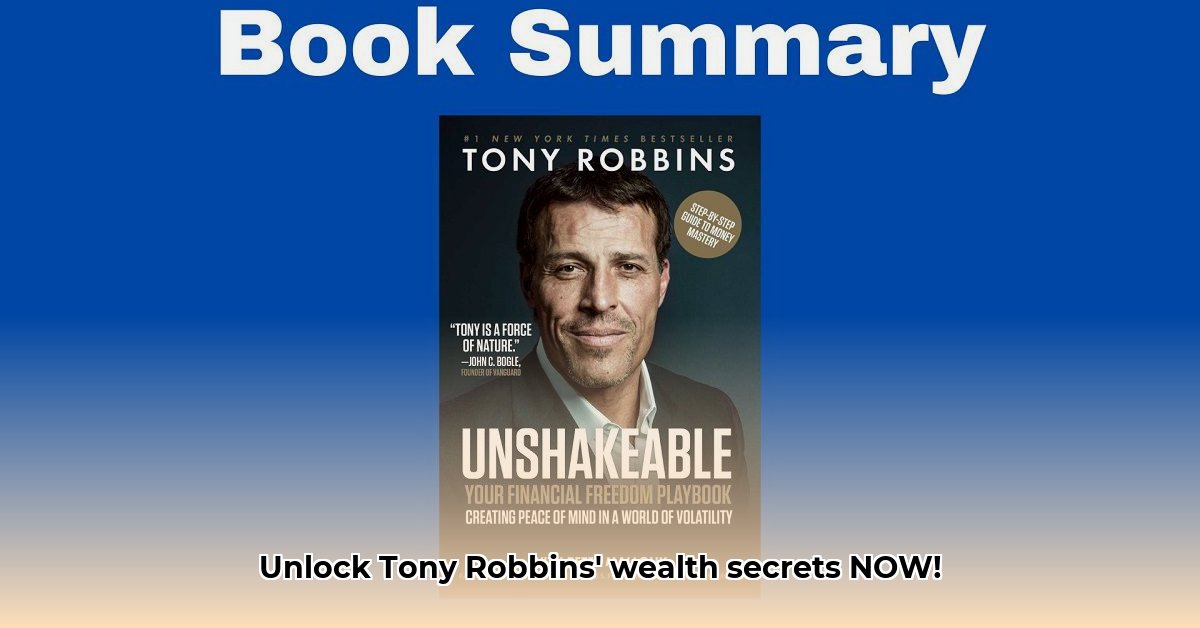
Tony Robbins' Wealth-Building Strategies: Your Path to Financial Freedom
Ready to take control of your financial future? This isn't a get-rich-quick scheme, but a proven roadmap to long-term financial success. Think of it like building a house: a solid foundation, strong walls, and a reliable roof. Each step is crucial. This guide outlines Tony Robbins' wealth-building strategies, focusing on actionable steps you can take today. To learn more about Tony Robbins' personal financial success, check out his net worth.
Laying the Foundation: Mastering Your Money Mindset
Before investing, understand your relationship with money. Are unexpected market dips stressful? Robbins emphasizes managing your financial emotions—not ignoring them, but developing a rational approach. This is crucial for long-term success. Consider journaling your financial thoughts and feelings to understand your money mindset.
Step 1: Create a Realistic Budget: Your Financial Compass
A budget isn't restrictive; it's your roadmap to financial clarity. Track income and expenses—every penny counts. Numerous apps and spreadsheets can help. Identify areas to cut back mindfully, focusing on conscious spending choices. The goal isn't deprivation, but mastering your finances.
Step 2: Smart Investing: Diversification Is Key
Diversify! Don't put all your eggs in one basket. Robbins suggests spreading investments across asset classes: stocks, bonds, real estate, perhaps even precious metals. For beginners, low-cost index funds and exchange-traded funds (ETFs) (mutually-owned investment companies that trade like stocks) offer broad market exposure with minimal fees. Consistent, long-term investing trumps chasing short-term gains. Consider consulting a financial advisor for personalized guidance.
Step 3: Tax Optimization: Keeping More of Your Earnings
Smart tax planning is vital. Maximize tax-advantaged accounts like 401(k)s and IRAs (retirement savings plans offering tax advantages) to lower your tax bill and boost savings. Explore other tax-saving strategies; professional advice is invaluable. Strategic tax planning can yield significant long-term savings.
Step 4: Build Your Financial Dream Team: The Power of Professional Guidance
While Robbins provides a powerful framework, professional help is beneficial. A financial advisor, ideally a fiduciary (someone legally obligated to act in your best interest), can navigate complex topics like estate planning and create a custom investment strategy. They offer objective perspectives you might miss. View this as building a support team for your financial aspirations.
Managing Inevitable Risks: Preparing for the Unexpected
No investment is risk-free. Markets fluctuate; unexpected events happen. Let's look at mitigation strategies:
| Risk Factor | Mitigation Strategy |
|---|---|
| Market Volatility | Diversify; maintain a long-term view. |
| Inflation | Include inflation-protected assets in your portfolio. |
| High Investment Fees | Choose low-cost index funds or ETFs. |
| Emotional Decision-Making | Establish a well-defined plan and stick to it; seek professional guidance. |
| Advisor Selection | Thoroughly research and vet potential advisors; check credentials. |
| Unexpected Life Events | Build an emergency fund; consider life insurance and disability insurance. |
Implementing Tony Robbins' Investment Strategy: The Three-Bucket System
Tony Robbins' approach often involves a "three-bucket" system for long-term wealth building. Let's explore its implementation.
Understanding the Three-Bucket System
Security Bucket: Your safety net—3-6 months of living expenses in readily accessible, low-risk investments (e.g., high-yield savings accounts or short-term bonds). Goal: peace of mind.
Growth Bucket: Long-term investments for growth (e.g., stocks, real estate). Patience is key.
Dream Bucket: For aspirations—that dream vacation, a down payment, early retirement—reflecting longer timelines.
Asset Allocation: Finding Your Balance
The percentage allocation across buckets depends on your age, risk tolerance, and goals. A common starting point might be 40% security, 50% growth, 10% dream, but personalize it. Assess your risk tolerance: are you comfortable with potential short-term losses for greater long-term gains?
Minimizing Fees: Maximizing Returns
Investment fees erode returns. Choose low-cost index funds or ETFs. This crucial step directly impacts your financial independence journey.
Mastering the Psychology of Investing
Investing is emotional. Avoid impulsive decisions based on market fluctuations. A well-defined plan, regular reviews, and a financial advisor can help navigate emotional challenges.
Practical Steps to Implementation
- Define your goals: What are your short-term and long-term financial aspirations?
- Assess your risk tolerance: How comfortable are you with potential losses?
- Create your three-bucket structure: Allocate assets according to your risk profile and goals.
- Choose low-cost investments: Minimize fees to maximize growth.
- Regularly review and rebalance: Adapt your strategy as circumstances change.
- Seek professional advice: Consider a financial advisor for personalized guidance.
Risk Management: The Importance of Diversification
Investing involves risks. Diversification helps mitigate, but doesn't eliminate, risk. Understanding and accepting these risks is crucial for long-term success. A well-diversified portfolio and informed decision-making are key.